Gaius Marius › Galatia › The Step Pyramid of Djoser » Origins and History
Articles and Definitions › Contents
- Gaius Marius › Who Was
- Galatia › Ancient History
- The Step Pyramid of Djoser › Antique Origins
Ancient civilizations › Historical places, and their characters
Gaius Marius › Who Was
Definition and Origins
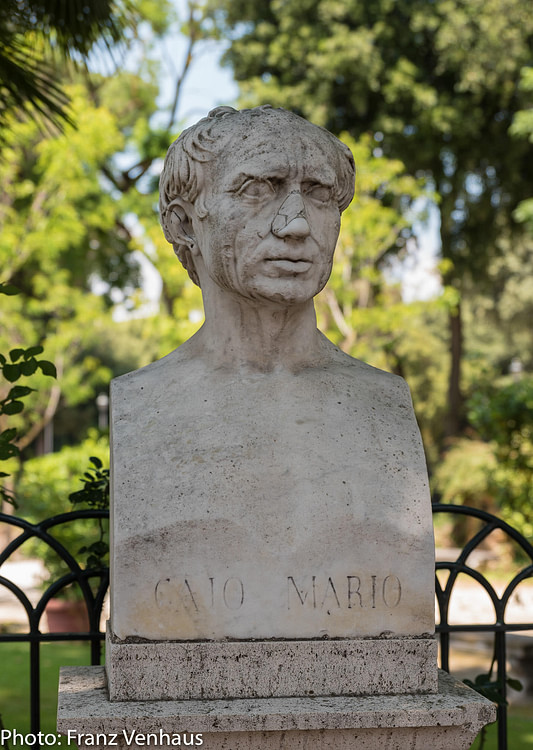
Gaius Marius (c. 157-86 BCE) was an accomplished military commander and politician who was acclaimed for saving Romefrom the brink of collapse. Yet, unfortunately, his name has only survived in relative obscurity because his achievements were eclipsed by his ultimate fall. Despite his copious misdeeds, he should also be remembered for his stunning political and military successes and the indelible imprint that he left on Rome.
EARLY LIFE
Around 157 BCE, Marius was born to a plebeian family in an Italian settlement called Ceraete, near Arpinum. None of Marius' ancestors had ever been elected to a Roman political office, and he even claimed to have been raised in poverty, which meant that he was not seriously expected to become a person of importance.
At an early age, he entered Rome's legions and served with integrity. Then, by parlaying his relationships with influential Romans and expounding his honorable military service, he entered the political arena and climbed the political ladder, thecursus honorum. He was first elected to the military tribuneship, then tribune of the plebs in 119 BCE, praetor in 115 BCE, and he was subsequently assigned to govern the province of Farther Spain. Throughout his early political career, he proved that he was an adept and conscientious politician. In fact, Marius "won office after office, always so conducting himself in each of them as to be regarded worthy of a higher position than that which he was holding" (Sallust, The War with Jugurtha, 63.5).
JUGURTHINE WAR
After his governorship, Marius' political career temporarily went cold. In the interim, he married a patrician woman named Julia who later boasted a famous nephew, Julius Caesar, but Marius' intermission from public life was short-lived. In 109 BCE, Consul Quintus Caecilius Metellus was assigned to conclude the ongoing embarrassing conflict with the wily King Jugurtha of Numidia. Metellus, in turn, appointed Marius as his legate, which was an immense opportunity. The two traveled to Africa where they retrained the legions and attempted to engage Jugurtha, but Marius eventually concluded that Metellus' leadership was lacking and his strategy was too conservative.
MARIUS THANKLESSLY STRIPPED METELLUS OF THE NUMIDIAN COMMAND, & THEN HAD IT TRANSFERRED TO HIMSELF.
So, Marius sailed to Rome where he implemented an effective campaign strategy of pandering to the lowest strata of society and thoroughly demonizing the aristocracy. His ploy worked, and he was resoundingly elected to the consulship of 107 BCE.Then he flexed his political muscle, thanklessly stripped Metellus of the Numidian command, and then had it transferred to himself.
Marius promptly recruited a much larger army, including volunteers from the poorest classes, which was contrary to Roman policy, and he altered the Numidian strategy. Then he set out to confront Jugurtha. Before long, Marius exacted stinging defeats upon the Jugurthine coalition, which left tens of thousands of Rome's foes slain and applied pressure on the Numidian's allies. By 105 BCE, one of Jugurtha's supposed friends agreed to capture and deliver the shrewd albeit beleaguered king to the Romans, and one of Marius' able officers, Sulla, oversaw Jugurtha's final surrender. Once Jugurtha was in Marius' custody, it signaled the end of the conflict, largely thanks to Marius' military operations and troop surge.
CIMBRIC WAR
There was little time to celebrate because a mighty northern barbarian tribe called the Cimbri emerged and imperiled the Republic. The Cimbri established a fearsome alliance with the Teutones, Ambrones, and others to challenge Rome. In response, in 105 BCE, Marius was unconstitutionally elected in absentia to his second consulship, and he was tasked with defending the Republic from the barbarian coalition. After celebrating a splendid Roman triumph, Marius traveled to the north with his army, trained them, and prepared for a campaign that might determine Rome's fate, but the barbarian alliance did not arrive as expected. For a couple years he waited, and each year, the Roman people unconstitutionally re-elected him as consul.
Finally, in 102 BCE, Marius' scouts reported the barbarians' advance in two, possibly three columns. Marius rushed to meet the tribesmen, but he sagaciously chose to engage the tribes individually and only after each had committed a strategic error.First, he defeated and methodically slaughtered the Ambrones, and subsequently the Teutones in the vicinity of Aquae Sextiae. Then, after being re-elected as consul for 101 BCE, Marius clashed with the Cimbri and systematically massacred them, ending the long-running conflict. During this single war, the Romans had killed an estimated 360,000 and apprehended another 150,000 who were promptly sold into slavery.
MILITARY REFORMS
During Marius' long tenure as a military commander, he proved to be an innovative general who instituted many reforms. Some of which remained in the legions for many years. While preparing to head to Africa to clash with Jugurtha, he enlisted Romans of all classes into his army, including the poor. This was contrary to Roman policy. However, it greatly expanded the Republic's recruitment pool and eventually became standard operating procedure in old Rome.

Silver Denarius Depicting Legionary Eagle
During the Cimbric War, he strove to rid his army of as many of its slow-moving pack animals as possible so that his troops would be quick and nimble. Thus, he required his legionaries to carry most of their supplies. While many soldiers complained about this added burden, this proved to be a commonsense and effective reform that became permanent. In a less than tactical move, Marius is also imputed with being the person who began the habit of only topping Roman legionary standards with a silver eagle. Originally, standards were adorned with the image of any one of multiple animals, but the eagle became a long-lasting mainstay of the legions thanks to Marius.
MARIUS' SIXTH CONSULSHIP
Following the Cimbric War, Marius returned to Rome to a thankful populace who considered him one of Rome's founders and awarded him with his second magnificent triumph, and they even ritually offered libations to him. At this point, he sought the consulship once again but resorted to bribing voters, which ensured his election. Once he was in office in 100 BCE, he continued an ill-advised alliance with unscrupulous politicians, including Saturninus who ultimately revolted against the state.Marius begrudgingly responded, raised a force, and successfully neutralized Saturninus. However, many Romans turned against Marius because they realized that he had initially partnered with a murderous and seditious outlaw. As a result, his once vast influence waned to an extent.
SOCIAL WAR
Consequently, Marius quietly passed the next several years as an elder member of the Roman Senate, but by 91 BCE, disaster broke out near Rome as the Republic's Italian allies revolted, which sparked the calamitous Social War. The ruling Roman elites requested that Marius and other accomplished military men lead Rome's troops against the Italians, and Marius dutifully obeyed and competently commanded legions throughout 90 BCE. However, after one campaign season, he retired, publicly citing infirmities, but he was likely forced out of power by his senatorial enemies.
STRUGGLE FOR THE MITHRIDATIC COMMAND

Mithridates VI Eupator of Pontus
Before departing a second time to confront Mithridates, Sulla declared Marius an enemy of the state, placed a bounty on his head, and sentenced him to die. As a result, Marius lived the life of a desperate fugitive, and he endured many humiliations and close brushes with death. He ultimately fled to Africa, where he dodged his enemies and slowly assembled a small force for his eventual return to Rome. By 87 BCE, the Republic's two consuls, Cinna and Octavius, were in the midst of a violent spat, which provided Marius a chance to return. So, he sailed toward Italy with his newly levied troops, and he obediently offered to serve Consul Cinna.
RETURN TO ROME
Consequently, Marius aided Cinna, and before long Cinna's co-consul was outmaneuvered and was forced to surrender, allowing Marius and Cinna to both re-enter Rome. However, they were not gracious victors. Marius had once assiduously safeguarded Rome, but he and his partner, Cinna, turned their attention toward settling their own personal vendettas. Then they slaughtered their domestic foes without trials. While the ancient historians, who were often hostile toward Marius, claimed that this was a widespread purge, "the most assiduous researchers can only attribute responsibility for seven of the fourteen known victims to [Marius]" (Carney, 67). Certainly, there may have been many more victims than this in the abhorrently immoral pogrom. However, it still paled in comparison to Sulla's eventual bloody proscriptions, which supposedly claimed the lives of thousands. Nevertheless, Marius' unrestrained vengeance utterly ruined his once largely commendable reputation.
Regardless of the killing spree, Marius and Cinna both declared their candidacy for the following year's consulship, and they were unsurprisingly elected. Marius achieved his prophesized seventh consulship, which was more than any other Roman had ever enjoyed up to that point, but his term was cut short. Mere days into it, his mind and body began to wither, and by mid-January, 86 BCE, he died, reportedly of pleurisy, at around the age of 70. Marius likely enjoyed an elegant funeral, but unfortunately, this was not the last time that Romans glimpsed him. When Sulla returned from defeating Mithridates, he initiated an unrestrained massacre, and he ordered his subordinates to exhume Marius' decaying remains, whereby they were abused and discarded as odious trash. This "was an ignominious end and the ultimate dishonour for the once-hero-turned-pariah of Rome" (Hyden, 253).
Galatia › Ancient History
Definition and Origins
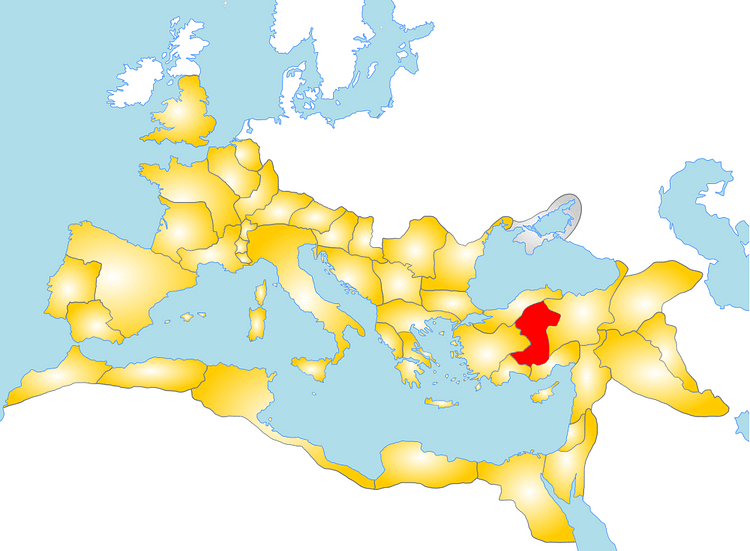
Ancient Galatia is located in the central regions of modern-day Turkey, a poor land traditionally inhabited by the Phyrgians.Later this land was controlled and inhabited by Celtic tribes some time in the 270's BCE Celtic tribes in Thrace and elsewhere were invited by Nicomedes I of Bithynia to come over into Anatolia to serve as warriors and mercenaries. The term 'Galatae' was used by the Greeks to denote these Celtic tribes. Once the Galatian tribes crossed over in Anatolia, they were soon the preeminent power in the region. Raids upon nearby regions were soon commonplace. Livy writes,
To the Trocmi the coast of the Hellespont as assigned (as raiding land); the Toistoboii received by the lot Aeolis and Ionia ; the Tectosages the interior parts of Asia. And they enacted tribute from all of Asia on this side of the Halys. And so great was the terror of their name, their numbers being so enlarged by great natural increase, that in the end even the kings of Syria did not refuse to pay them tribute.
THE THREE MAIN TRIBES OF GALATIA WERE THE TROCMI, TOLISTOBOII, AND THE TECTOSAGES.
All this came to an end during the 'elephant battle ' against the Seleucids. The Galatians were defeated and settled down in central Asia Minor where they would continue to periodically launch raids and campaigns into he surrounding lands. The three main tribes of Galatia were the Trocmi, Tolistoboii, and the Tectosages. The Trocmi had as their capitol the town of Tavium, but also Mithridatum, Eccobriga, and Danala. The Tectosages ruled from Ankyra. They also had a settlement known as Pitobriga and they renamed the town of Gordium to Vindia, a place where they had a large market of trading goods. The Tolistoboii were centered around Blucium, later a fortress of King Deiotarus, and also Peium, an oppida where Deiotarus kept his massive treasury. Pessinus would later become the capitol of the Tolistoboii by 25 BCE during Roman annexation. The Teutobodiaci were a clan or sept within the Tectosages and the tribes of the Voturi, Ambituti, and Tosiopes were clans of the Tolistoboii.
Though little is known of the Galatians through discoveries in archaeology, the government of Galatia is known. Each tribe was split into four clans, each ruled by a tetrarch (from the Greek word tetra- meaning 'four' and arkos meaning 'chief'). These rulers were in turn supported by a chief judge, a leading general, and two deputy generals. This system held for a long time in Galatia, yet later the tetrarchs seem to have became petty kings. 300 senators held a national assembly that is thought to have been held at Drunemeton ('sacred oak sanctuary'). Despite all this the Galatians often fought among themselves and established no unified kingdom, although Ortagion, by forging alliances in the region, certainly came close to doing so. There is no mention of major problems living among the local Phyrgians nor mention of uprisings while the Galatians were away on campaign. in fact classical writers allude to their intermarrying with them.
The Galatians also adopted many aspects of Greek culture. These Celts were later known as Gallogracians, those who had Phyrgian, Greek, or other local influences in their blood and or lifestyle. Livy, quoting Manlius Vulso who defeated the Galatians in two battles in 189 BCE mentioned "that some of these Gauls (Galatians) are a mixed race, truly described by their name Gallogracians." This evidence is further backed up by the inscriptions at Delphi mentioning that among the Galatians were freed slaves of areas that they had swept through. Despite this, the Galatians were known to deal in slaves.
The Step Pyramid of Djoser › Antique Origins
Ancient Civilizations
The pyramids are the most famous monuments of ancient Egypt and still fascinate people in the present day. These enormous tributes to the memory of the Egyptian kings have become synonymous with the country even though other cultures (such as the Chinese and Mayan) also built pyramids. The evolution of the pyramid form has been written about and debated for centuries but there is no question that, as far as Egypt is concerned, it began with one monument to one king designed by one brilliant architect: the Step Pyramid of Djoser at Saqqara.
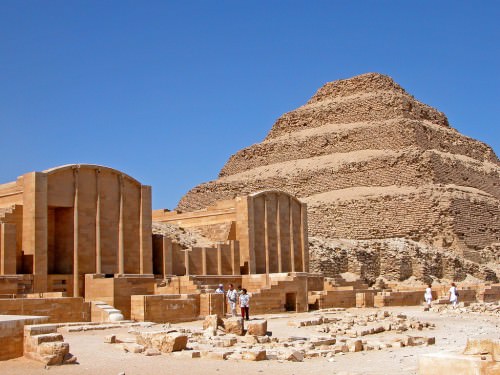
Step Pyramid Complex at Saqqara
Djoser (c. 2670 BCE) was the first king of the Third Dynasty of Egypt and the first to build in stone. Prior to Djoser's reign, mastaba tombs were the customary form for graves: rectangular monuments made of dried clay brick which covered underground passages where the deceased was entombed. For reasons which remain unclear, Djoser's vizier, Imhotep (c. 2667 BCE), conceived of building a more impressive tomb for his king by stacking mastabas on top of one another, progressively making them smaller, to form the shape now known as the Step Pyramid.
DJOSER'S VIZIER, IMHOTEP CONCEIVED OF BUILDING A TOMB FOR HIS KING BY STACKING MASTABAS ON TOP OF ONE ANOTHER TO FORM THE SHAPE NOW KNOWN AS THE STEP PYRAMID.
Little is known of Djoser's reign. He is thought to be the son of the last king of the Second Dynasty of Egypt, Khasekhemwy (c. 2680 BCE). His mother was the queen Nimaathap and his wife the queen Hetephernepti, who was probably his half-sister.Djoser was an ambitious builder of monuments and temples. He is thought to have reigned for twenty years but historians and scholars usually attribute a much longer time for his rule owing to the number and size of the monuments he had built.
Djoser was highly respected during his reign and still, centuries after, was held in high regard as evidenced by the Famine Stele from the Ptolemaic Dynasty (332-30 BCE) which tells the story of Djoser saving the country from famine by re-building the temple of Khnum, the god of the source of the Nile River, who was thought to be holding back his grace because his shrine was in disrepair; once Djoser restored it, the famine was lifted. None of Djoser's accomplishments or building projects are as impressive, however, as his eternal home at Saqqara.
CONSTRUCTION
The Step Pyramid has been thoroughly examined and investigated over the last century and it is now known that the building process went through many different stages and there were a few false starts. Imhotep seems to have first begun building a simple mastaba tomb. The highest mastaba was 20 feet (6 meters) but Imhotep decided to go higher. Investigations have shown that the pyramid began as a square mastaba, instead of the usual rectangular shape, and then was changed to rectangular. Why Imhotep decided to change the traditional rectangular mastaba shape is unknown but it is probable that Imhotep had in mind a square-based pyramid from the start.
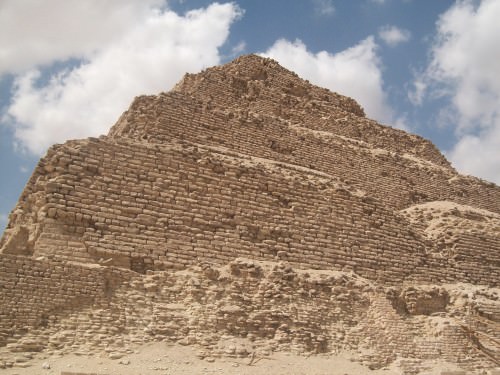
Detail, Step Pyramid of Djoser
The early mastaba was built in two stages and, according to Egyptologist Miroslav Verner,
... a simple but effective costruction method was used. The masonry was laid not vertically but in courses inclined toward the middle of the pyramid, thus significantly increasing its structural stability. The basic material used was limestone blocks, whose form resembled that of large bricks of clay (115-116).
The early mastabas had been decorated with inscriptions and engravings of reeds and Imhotep wanted to continue that tradition. His great, towering mastaba pyramid would have the same delicate touches and resonant symbolism as the more modest tombs which had preceded it and, better yet, these would all be worked in stone instead of dried mud. Historian Mark Van de Mieroop comments on this, writing :
Imhotep reproduced in stone what had been previously built of other materials. The facade of the enclosure wallhad the same niches as the tombs of mud brick, the columns resembled bundles of reed and papyrus, and stone cylinders at the lintels of doorways represented rolled-up reed screens. Much experimentation was involved, which is especially clear in the construction of the pyramid in the center of the complex. It had several plans with mastaba forms before it became the first Step Pyramid in history, piling six mastaba-like levels on top of one another...The weight of the enormous mass was a challenge to the builders, who placed the stones at an inward incline in order to prevent the monument breaking up (56).
When completed, the Step Pyramid rose 204 feet (62 meters) high and was the tallest structure of its time. The surrounding complex included a temple, courtyards, shrines, and living quarters for the priests covering an area of 40 acres (16 hectares) and surrounded by a wall 30 feet (10.5 meters) high. The wall had 13 false doors cut into it with only one true entrance cut in the south-east corner; the entire wall was then ringed by a trench 2,460 feet (750 meters) long and 131 feet (40 meters) wide.The false doors and the trench were incorporated into the complex to discourage unwanted guests. If one wished to visit the inner courtyard and temples, one would have needed to have been told how to enter.
THE PYRAMID COMPLEX
The pyramid and its surrounding complex was designed to be stunning and inspire awe. Djoser was so proud of his accomplishment that he broke precedent of having only his own name on a monument and had Imhotep's name carved as well. The complex consists of the Step Pyramid, the House of the North, the House of the South, the Serdab, the Heb Sed Court, the South Tomb, Temple T, and the Northern Mortuary Temple. All of these, with the surrounding wall, made up a complex the size of a city in ancient Egypt. Djoser's complex, in fact, was larger than the city of Hierkanpolis at the time.
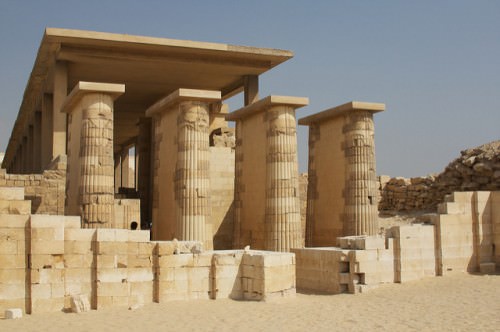
Temple at the Step Pyramid, Saqqara
The purpose of the House of the North and House of the South is unknown but it has been speculated they represented Upper and Lower Egypt. The Serdab ('cellar') is a limestone box near the northern entrance of the pyramid where a life-sized statue of Djoser was found. This statue would have been of great importance to the soul of the king in the afterlife.
The soul was thought to consist of nine aspects and one of them, the ba (the bird-shaped image often found on tomb engravings), was able to fly from earth to the heavens at will. It required some recognizable landmark on earth, however, and this would have been the pyramid with the likeness of the king in front of it. Once the ba, high above, saw the home of its owner, it could swoop down, enter, and visit the earthly plane again. The importance of names and images of pharaohs comes into play here in that the soul needed to be able to recognize its former home (physical body) on earth in order to be at rest in the afterlife. The statue of Djoser, erected at the complex, is the oldest known life-sized Egyptian statuary extant and would have been created for this purpose as well as to remind visitors of the great king's legacy.
The Heb Sed Court was related to the Heb Sed Festival in which the king validated his right to rule. The festival was held in the 30th year of the king's reign and then every three years afterwards to revitalize his rule by re-enacting his coronation. This courtyard, which contains the House of the North and the House of the South, also has thirteen small chapels. The South Tomb has three carved panels depicting Djoser performing the Heb Sed ritual. This tomb is mastaba shaped and is thought to have been built to house another statue of the king. Temple T is among the most fascinating and mysterious structures in the complex. The outer facade of the building is plain and shows no efforts at ornamentation but the inside is beautifully constructed with Djed pillars (representing stability) throughout. There are intricate carvings inside as well, including one of a half-opened door which seems like an actual doorway. The meaning of this door carving is not clear but may have represented a symbolic passageway to the afterlife. The Northern Mortuary Temple, to the north side of the pyramid nearby, was used to access the subterranean passages of the pyramid which led down to the burial chamber.
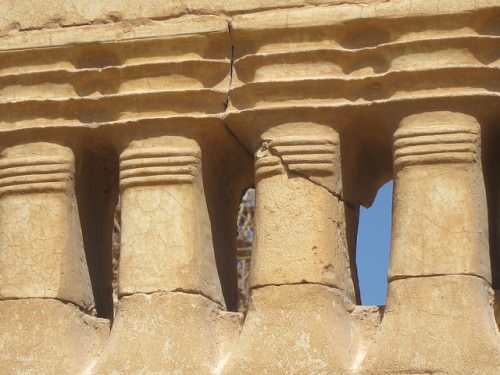
Djed pillars
THE STEP PYRAMID
The actual chambers of the tomb, where the king's body was laid to rest, were dug beneath the base of the pyramid as a maze of tunnels with rooms off the corridors to discourage robbers and protect the body and grave goods of the king. Djoser's burial chamber was carved of granite and, to reach it, one had to navigate the corridors which were filled with thousands of stone vessels inscribed with the names of earlier kings. The other chambers in the subterranean complex were for ceremonial purposes. Historian Margaret Bunson writes:
The subterranean passages and chambers were adorned with fine reliefs and with blue faience tiles made to resemble the matted curtains of the royal residence at Memphis. The great shaft of the structure, leading to the burial chamber, was 92 feet long. The chamber at the bottom was 13 feet high, encased in granite. A granite plug sealed the passageway to the actual tomb. Mazes were also incorporated into the design in order to foil potential robbers (253).
The underground passages are vast and one of the most mysterious discoveries inside are the stone vessels. Over 40,000 of these vessels, of various form and shape, were found in two of the descending shafts of the pyramid (the 6th and 7th shafts).These vessels are inscribed with the names of rulers from the First and Second Dynasty of Egypt and are made from all kinds of stone such as diorite, limestone, alabaster, siltstone, and slate. Names of the kings Narmer, Djer, Den, Adjib, Semerkhet, Ka, Heterpsekhemwy, Ninetjer, Sekhemib, and Khasekhemwy all appear on these vessels as well as non-royal names of lesser personages.
There is no agreement among scholars and archaeologists on why the vessels were placed in the tomb of Djoser or what they were supposed to represent. The archaeologist Lauer, who excavated most of the pyramid and complex, believes they were originally stored by Khasekhemwy toward the end of the Second Dynasty and were given a "proper burial" by Djoser in his pyramid to honor his predecessors. There are other historians, however, who claim the vessels were dumped into the shafts as yet another attempt to prevent grave robbers from getting to the king's burial chamber.
Unfortunately, all of the precautions and intricate design of the underground complex did not prevent ancient robbers from finding a way in. Djoser's grave goods, and even his mummy, were stolen at some point in the past and all archaeologists found of the king was parts of his mummified foot and a few valuables overlooked by the thieves. There was enough left to examine throughout the pyramid and its complex, however, to amaze the archaeologists who excavated it.
DISCOVERY
As with many of the monuments of Egypt, visitors and thieves explored the pyramid complex for centuries after it was abandoned but no systematic exploration was undertaken until Napoleon's Egypt campaign 1798-1801 CE. Napoleon brought a team of scholars and scientists along with his army who explored, examined, recorded, and studied the monuments of ancient Egyptian culture and who, among other accomplishments, discovered the Rosetta Stone in 1799 CE, the trilingual inscription stele which enabled French scholar Jean-Francois Champollion (1790-1832 CE) to decipher the Egyptian hieroglyphs and open up the history of ancient Egypt for the world. Napoleon's expedition was the first systematic study of the civilization and, later, led to the first western museum to install a permanent Egyptian wing at the Louvre in Paris.
Following Napoleon's artists and scientists, German, English, and Prussian archaeologists and researchers visited the Step Pyramid throughout the 19th century but no critical, scientific, examination was begun until the 1920's CE when the English archaeologist Cecil Mallaby Firth (1878-1931 CE) arrived at the site. It was Firth who, in 1924 CE, discovered the Serdab and Djoser's statue. In 1926 CE, Firth was joined on site by the French architect and Egyptologist Jean-Philippe Lauer (1902-2001 CE) who would make the major discoveries at the complex and contribute the most to modern-day understanding of pyramid construction generally and the Step Pyramid specifically.

Djoser
Lauer restored, excavated, and explored the Step Pyramid and its complex for the next fifty years. He uncovered the shafts and burial chambers, found and restored the blue faience rooms, and devoted himself to bringing the ancient site back to life.Much of what one sees today in visiting the site is due to Lauer's personal efforts or those he mentored and inspired like the Egyptologist Zakaria Goneim. Lauer preserved Imhotep's grand design and brought to light the intricacies of the complex which had been overlooked by Firth and those who'd worked with him. Unfortunately, the pyramid and its grand complex today is in danger of collapse owing to an earthquake which shook the region in 1992 CE and inadequate and incompetent efforts taken to preserve and restore it.
DANGER OF COLLAPSE & PRESERVATION EFFORTS
A September 2014 article by Beverley Mitchell for the on-line magazine Inhabitat notes how the Egyptian Supreme Council of Antiquities hired a company which had never worked on ancient sites before and the pyramid was in critical condition. Giant air bags were inflated under the pyramid while construction work was done but, to date, the chambers beneath the monument are still in danger of collapsing and the complex surrounding the monument is unstable. Mitchell writes, "it is a tragedy that such an important archaeological legacy could be destroyed by incompetence and lack of adequate funding" which is entirely true and should be self-evident to all; but nothing of significance has been done to preserve the pyramid or the complex in the last two years.
Miroslav Verner writes, "Few monuments hold a place in human history as significant as that of the Step Pyramid in Saqqara...It can be said without exaggeration that his pyramid complex constitutes a milestone in the evolution of monumental stone architecture in Egypt and in the world as a whole (108-109)." The Step Pyramid was a revolutionary advance in architecture but, just as importantly, it became the archetype which all the other great pyramid builders of Egypt would follow.The design of the Step Pyramid influenced the builders of the famous pyramids and their complexes in the Fourth Dynasty including the Great Pyramid of Giza, last of the Seven Wonders of the Ancient World. Hopefully, preservation efforts at Djoser's Step Pyramid will improve in time to save this unique site for visitors to appreciate and admire in the future as they have for the past 4,000 years.
LICENSE:
Article based on information obtained from these sources:with permission from the Website Ancient History Encyclopedia
Content is available under License Creative Commons: Attribution-NonCommercial-ShareAlike 3.0 Unported. CC-BY-NC-SA License